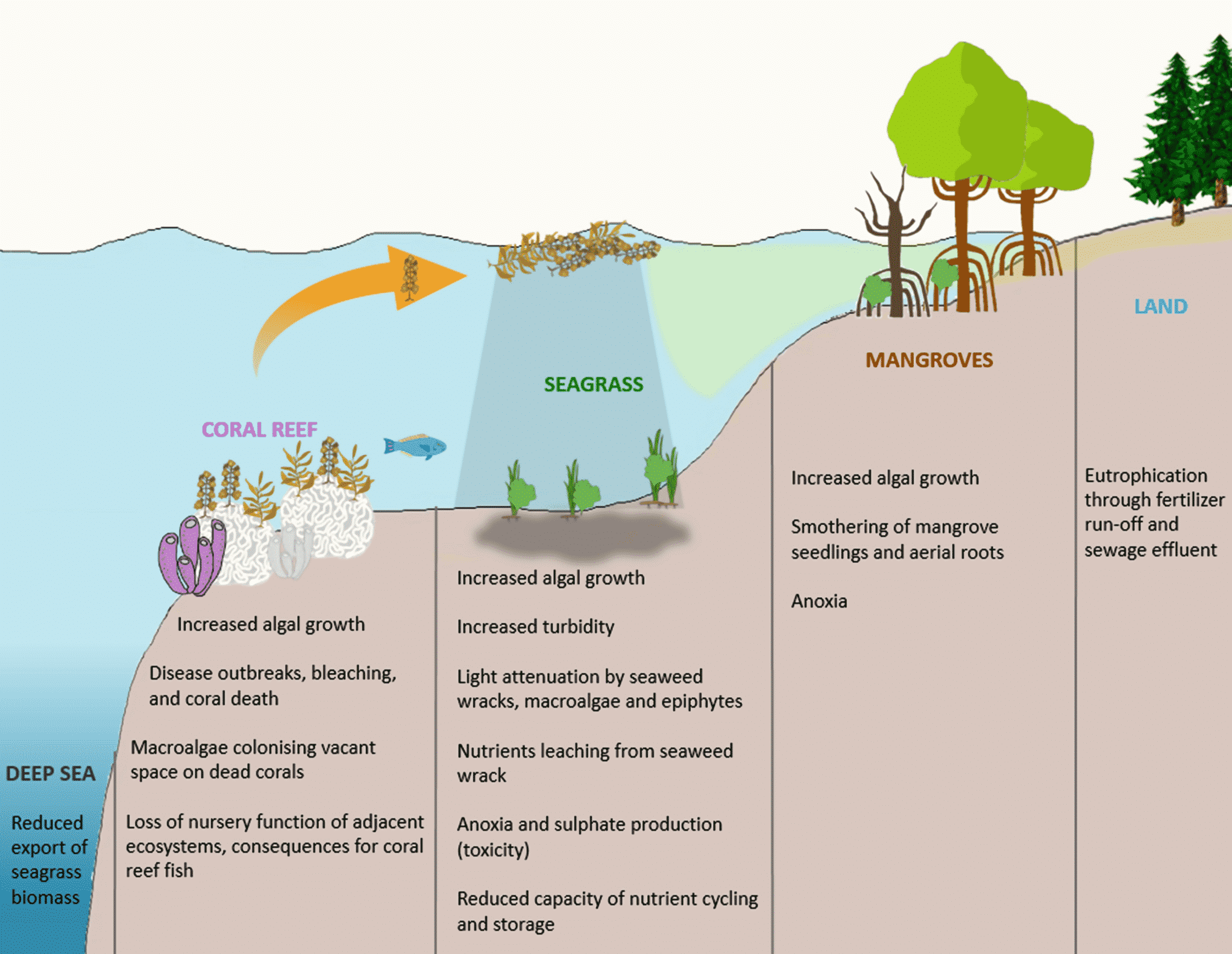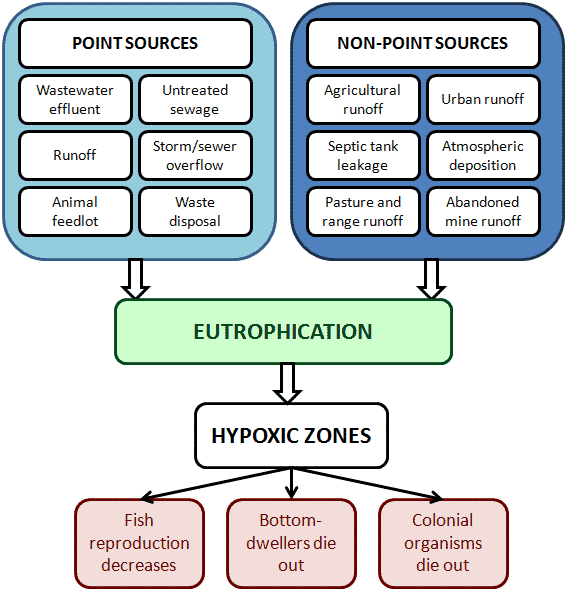Causes of Eutrophication and Algal bloom | UPSC – IAS
Eutrophication derives from the Greek word eutrophos, meaning nourished or enriched. Eutrophication is the natural aging of a lake by biological enrichment of its water. In a young lake the water is cold and clear, supporting little life. With time, streams draining into the lake introduce nutrients such as nitrogen and phosphorus, which encourage the growth of aquatic organisms. In other words, the Eutrophication refers to the addition of artificial or non-artificial substances, such as nitrates and phosphates, through fertilizers or sewage, to a fresh water system. It can be anthropogenic or natural.
- Eutrophication leads to increase in the primary productivity of the water body or “bloom” of phytoplankton. The overgrowth causes the loss of oxygen in the water leading to severe reductions in fish and other animal populations.
- What is the cause of eutrophication ? – Domestic sewage, the most common source of pollution of water bodies, reduces dissolved oxygen but increases biochemical oxygen demand of receiving water. Domestic sewage is rich in nutrients, especially, nitrogen and phosphorus, which cause eutrophication and nuisance algal blooms.
Types of Eutrophication | UPSC – IAS
Eutrophication is mainly divided into natural and cultural Eutrophication.
Natural Eutrophication
- In natural Eutrophication, a lake is characterized by nutrient enrichment. During this process an oligotrophic lake is converted into an eutrophic lake. It permits the production of phytoplankton, algal blooms and aquatic vegetation that in turn provide ample food for herbivorous zooplankton and fish.
- While Cultural Eutrophication is caused by human activities. Which in turn are responsible for addition of 80% nitrogen and 75% phosphorus to lake and streams.
Accelerated or Cultural Eutrophication
- Over the centuries, as silt and organic debris pile up, the lake grows shallower and warmer, with warm-water organisms supplanting those that thrive in a cold environment. Marsh plants take root in the shallows and begin to fill in the original lake basin. Eventually, the lake gives way to large masses of floating plants (bog), finally converting into land.
- Depending on climate, size of the lake and other factors, the natural aging of a lake may span thousands of years. However, pollutants from human activities like effluents from the industries and homes can radically accelerate the aging process. This phenomenon has been called Cultural or Accelerated Eutrophication.
- In other words when the process of Eutrophication is increased by the human activities, it is called cultural or accelerated Eutrophication. This is because the human activities (mainly development in nature) increase the surface runoff and the nutrients such as Phosphates, Nitrates are supplied to the Ocean water. They may be supplied by Constriction works, treatment plants, golf courses, fertilizers, and farms.
Features of Eutrophication | UPSC – IAS
- Eutrophication escalates rapidly when high nutrients from fertilizers, domestic and industrial wastes, urban drainage, detergents and animal, sediments enter water streams.
- Eutrophication causes several physical, chemical and biological changes, which considerably deteriorate the water quality.
- It creates algal bloom, releases toxic chemicals that kill fish, birds and other aquatic animals.
- Decomposition of algal bloom leads to the depletion of oxygen in water. Thus with a high CO2 level and poor oxygen through reduction of nitrates.
- On complete exhaustion of nitrate, oxygen may as last resort be obtained by reduction of sulphate yielding hydrogen sulphide causing foul smell and putrefied taste of water. Many pathogenic microbes, viruses, protozoa and bacteria and grow on sewage products under anaerobic conditions. It results into the spread of fatal water-borne disease such as polio, dysentery, diarrhoea, typhoid and viral hepatitis.
Ways to control Eutrophication | UPSC – IAS
- Several prevention and technical devices have been used to control Eutrophication. The wastewater must be treated before its discharge into water streams.
- Recycling of nutrients can be checked through harvest. Removing nitrogen and phosphorous at the source, division of nutrient-rich waters from the receiving bodies and dilution of these elements can minimize Eutrophication.
- Algal blood should be removed upon their death and decomposition. Limiting the dissolve nutrients can control algal growth. The most suitable, feasible and effective method involves the use of chemicals to precipitate additional phosphorus.
- Precipitants like alum, lime, iron and sodium aluminate may be used. Physicochemical methods can be adopted to remove nutrients. for example phosphorus can be removed by precipitation and nitrogen by nitrification or denitrification.
- Electrodialysis, reverse osmosis and ion exchange methods. Copper-sulphate and sodium arsenite are employed for killing algae and rooted plant respectively.
Relation between Viruses and Aquatic Ecosystem | UPSC – IAS
- A teaspoon of seawater contains about one million of Viruses, making them the most abundant biological entity in aquatic environments. They are useful in the regulation of saltwater and freshwater ecosystems. The Bacteriophage, which is harmless to plants and animals, play the most important role here.
- They infect and destroy the bacteria in aquatic microbial communities, comprising the most important mechanism of recycling carbon in the marine environment. However, the organic molecules released from the bacterial cells by the viruses stimulate fresh bacterial and algal growth. Viruses are useful for the rapid destruction of harmful algal blooms that arises generally from the Blue Green algae and often kills other marine life.
- Viruses increase the amount of Photosynthesis in Oceans and are responsible for reducing the amount of carbon dioxide in the atmosphere by approximately 3 giga-tonnes of carbon per year.




